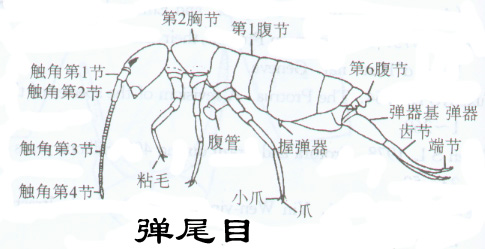Commonly known as springtails, because it has a bouncer at the end of its abdomen, hence the name Collembola. Its first abdominal segment has a sucker-shaped abdominal tube, and its fourth abdominal segment has a bifurcated jumper. The jumper is usually sucked by the suction tube. When necessary, the sucker-shaped abdominal tube is loosened and bounced through the jumper, that is, Can jump.

Small, body length is generally only 1-3 mm. There are 8 ocelli on each side, but some species have no ocelli. The antennae have 4 segments; the legs have no tarsal segments. If the abdomen is composed of 6 segments, it is called Collembola (general springtails); if the 6 abdominal segments heal into a spherical shape, it is called Collembola (round springtails).
There are about 6,000 known species in the world, and there are 193 species in my country. Springtails are found throughout the world, living in soil, among weeds, in humus, under tree bark, and in ant and termite nests. The density of springtails is astonishing. According to reports, 230 million springtails were found in a range of 1 acre of grass from the surface to a depth of 9 inches underground.
Some people in this category have been promoted to the Springtail Category. The characteristics of this species can be summarized as follows: the tail is good at jumping, with no more than six abdominal segments; there is an abdominal tube at the base, and the jumping organ is at the end.
animal tags: springtails insects
We created this article in conjunction with AI technology, then made sure it was fact-checked and edited by a Animals Top editor.